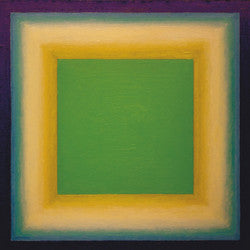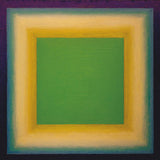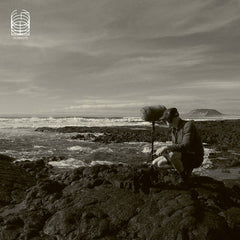Akos Rozmann // 12 Stations/Tolv Stationer (1978-2001) 7xCD BOXSET
- Availability:
ハンガリー・ブダペストの実験音楽家Akos Rozmannの7CD BOXセットがこの度再発。
以下、Mark Harwoodによる解説です。
アコス・ロズマン(1939-2005)はブダペストで生まれ、リスト音楽院でオルガンと作曲を学んだ。1971年から1974年までストックホルム王立音楽大学で作曲を学び、1978年からはストックホルムのカソリック大聖堂のオルガニストとして活躍した。生涯を通じてムジーク・コンクレートに専念し、あらゆる音楽のジャンルの中で最も錬金術的なこのジャンルにおいて、最も大規模で実りある作品群を作り上げた。80年代初頭には、カトリック大聖堂の地下に電子音響スタジオを建設し、その一方で、初期の傑作を生み出したEMS(Elektronmusikstudion スウェーデン)でも活動を継続した。
音楽創作への揺るぎないこだわりを持つロズマン氏は、望む結果を得るために、窓のないスタジオに閉じこもって夜通し作業をすることもしばしばあった。彼は、自分のビジョンを完璧に表現することだけを考え、仲間からの承認や聴衆の満足は求めなかった。このようなビジョン、情熱、頑固さの組み合わせが、ミュージック・コンクリートという分野で最も特異なカタログを生み出すことになった。ハンガリーの作曲家ミクローシュ・マロスから、ピアノと声のための5分間の作品を依頼された。ロズマンは、ミクローシュの妻でソプラノ歌手のイロナ・マロスの録音と、彼自身のプリペアド・ピアノの実験からなるテープ作品を書くつもりで、この申し出を受けた。ここで録音された要素が「12 Stations」の素材となった。この作品は、当初の5分という短い時間から大きく飛び出し、20年後に6時間半を超える精神の旅路として着地したのである。この作曲プロセスは、初期段階から最終作品の完成まで18年間のギャップがあるため、ロズマン作品の中でもユニークなものとなっている。1978年から1980年にかけて作られた最初の段階は、スピードアップ、スローダウン、テープのカットやスプライシングといった伝統的なミュジック・コンクレートの技法の探求で構成されています。1998年から2001年にかけて制作された最後の4つのステーションは、デジタル技術を取り入れ、1978年のオリジナル録音の小さなセクションをエフェクト・プロセッサーにかけ、サンプラーキーボードで即興演奏しています。このようなギャップや、それぞれの制作期間で展開された異なる技術にもかかわらず、記念碑的な結果は完全で驚異的な全体として収まっている。
ロズマンは、音源の制限の中で、オリジナルのピアノと声の録音から柔軟な音の世界を引き出す不思議な才能を発揮している。その結果、ダイナミックな音の渦が生まれ、20世紀における最も大胆で挑戦的、かつ見応えのあるムジーク・コンクレートの作品のひとつとなったのである。プロパティ・ルームパートIとIIは、シュトゥルム・ウント・ドランの広大な風景で始まる。ピアノと声のオリジナル素材は、攻撃的な異世界の雰囲気を呼び起こす手段として、分解・再構築されている。The Contents and Life of the Black Pit'は、重く堕落した声と狂乱したエレクトロニクスが最も不穏な方法で踊る広がりのある味付けでさらに外へとシフトしていく。The Abandonment of Hell'は、リスナーを洗練された衝撃的なオーディオの混乱に導き、明確な「音楽」の質を持つものである。この作品には、職人が静かに個々の要素を削ぎ落とし、以前は手に入れることのできなかった世界を手に入れようとしているのが感じられる。パートV「The Awakening」では、序盤のうなり声、腹鳴、不穏な声が、より天の声となり、下の異形のものを昇天させるように、ミックスに女性の形を埋め込んでいる。ロズマン氏は、「Twelve Stations」の最初の部分が「チベットの生命の輪」の解釈であることを以前に示唆していたが、作品の背後にある意味について典型的に曖昧な態度をとっていた。チベット仏教への関心と並行して、彼はカソリック教会への信仰を持ち続けていた。その結果、高揚したモチーフを持つこの曲は、地獄から天国への上昇と読むこともできるだろう。ロズマンが演奏する「The Celebrators」は、エンディングというより、ある種の継続として提示されている。短い音楽のリフレインは、声と音の屈折が鏡の回廊のように現れ、果てしなく螺旋状に広がっていくプリズムを思い起こさせる。
スケール、音色、テクニック、ムード、動きにおいて叙事詩的なこの作品は、20世紀のムジーク・コンクレーテのユニークな傑作であり、強烈にパーソナルで大胆な音の領域として、万人に開かれた過激なミサのような捧げ物として提示されている。
人間は放浪の旅を通して、さまざまな困難や苦しみに出会う。これらは、絶え間なく続く闘争の間にある力である。彼はこれらの力を制御し、主宰することはできない。嵐の中の雪片のように、上下に翻弄され、無力である。混沌とした思考と感情、喜びと苦しみは、始まりも終わりもない川のように途切れることなく流れている。これらはすべて自分の行いの結果である。しかし、この人生では、これらのことを簡単にするチャンスがある。
レーベルその他作品はこちら /// Click here to see more Shelter Press / Recollection GRM / Ideologic Organ releases available at Tobira.
------------------------------
Final pressing edition of 300.
7 CD’s packaged in a hardcover slipcase with a pull ribbon, 20-page booklet containing an extensive essay on the composition by the scholar Gergely Loch, photos from the process and of scores and the composer
***
Text / artist bio by Mark Harwood :
"Ákos Rózmann (1939-2005) was born in Budapest where he studied organ and composition at the Liszt Academy. From 1971 to 1974 he studied composition at the Royal College of Music in Stockholm and from 1978 he was an organist at the catholic cathedral in Stockholm. Throughout his life Rózmann dedicated himself to musique concrète developing one of the largest and most rewarding bodies of work in this, the most alchemical of all musical genres. In the early eighties, Rózmann started to build a private electroacoustic studio which he installed in the basement of the Catholic Cathedral whilst continuing to work in tandem at the Elektronmusikstudion (EMS Sweden) where he produced his earlier masterpieces.
With an unwavering commitment to the creation of music Rózmann would often lock himself up in his windowless studio working into the night in order to achieve the results he desired. He did not seek the approval of his peers nor the satisfaction of his audience with the only concern being the perfect articulation of his vision. This combination of vision, passion and stubbornness resulted in one of the most singular catalogues within the field of musique concrete. Commissioned by the Hungarian composer Miklós Maros who requested a five-minute work for piano and voice. Rózmann accepted the offer with the intention of writing a tape piece made from recordings of Miklós’ wife, the soprano singer Ilona Maros’ and his own experiments with prepared piano. The elements recorded here became the source material for Twelve Stations, a work which flew far from the initial five minute brief to land 20 years later as a spirit stretching journey of more than 6 1/2 hours. The compositional process is unique in Rózmann’s output due to the 18 year gap between the initial phase and completion of the final work. The first phase made between 1978-1980 consists of an exploration of traditional musique concrète techniques such as speeding up, slowing down, cutting and splicing tape. The last four stations made between 1998-2001 embrace digital technology where small sections of the original recordings from 1978 were fed through an effects processor and improvised on a sampler keyboard. Despite this gap and the different techniques deployed at each period of creation the monumental result sits as a complete and staggering whole.
Within the set limitations of the source material Rózmann’s skill unfolds in an uncanny ability to coax a vast world of flexible sound from the original piano and voice recordings. The result is a maelstrom of dynamic audio and one of the most daring, challenging and rewarding works of musique concrète from the 20th Century. ‘Property – Room’ parts I and II initiate proceedings with a vast landscape of Sturm und Drang. The original material of piano and voice are dissected and reconstructed as a means of evoking an aggressive otherworldly atmosphere. ‘The Contents and Life of the Black Pit’ shifts further outside with an expansive palate of heavily corrupted voice and frenzied electronics dancing in a most unsettling fashion. ‘The Abandonment of Hell’ leads the listener into a sophisticated and shocking melange of audio disorientation, one with a distinct ‘musical’ quality. One senses a master craftsman quietly whittling away at the individual elements in order to harness the previously unobtainable world within. Part V ‘The Awakening’ implants female forms in the mix as the growling, belching, disturbing voices of the early sequences are replaced with more heavenly voices ascending the malformed matter below. Rózmann was typically ambiguous about the meaning behind his work despite suggesting earlier that the first part of ‘Twelve Stations’ was an interpretation of the ‘Tibetan Wheel of Life’. Alongside his interest in Tibetan Buddhism he maintained his following of the catholic church and as a consequence one may also read this sequence, with its uplifting motifs as an ascent from hell into heaven. Rózmann concludes proceedings with ‘The Celebrators’, which presents itself not as an ending but rather a continuation of sorts. A short musical refrain conjures a prism where refractions of voice and sound appear like a hall of mirrors, spiralling onwards and outwards, without end.
Epic in scale, timbre, technique, mood and movement, Twelve Stations is a unique masterpiece of 20th Century musique concrète and presents itself as an intensely personal and bold realm of sound, an offering as such, a radical mass open to all.
Man meets different difficulties and sufferings through his wandering. These are forces between which a continuous struggle is going on. He cannot control and preside over these forces. He is being tossed up and down, powerless, like snowflakes in the storm: chaotic thoughts and feelings, gladness and suffering, which flow without intermission like a river that has no beginning nor end. All these are the fruits of our own deeds. However, in this life you have the chance to make easier those life wanderings that are to come. - Rózmann (from the programme notes for the 1984 premiere of the first seven stations)."
Artist : Akos Rozmann
Label : Ideologic Organ
ハンガリー・ブダペストの実験音楽家Akos Rozmannの7CD BOXセットがこの度再発。
以下、Mark Harwoodによる解説です。
アコス・ロズマン(1939-2005)はブダペストで生まれ、リスト音楽院でオルガンと作曲を学んだ。1971年から1974年までストックホルム王立音楽大学で作曲を学び、1978年からはストックホルムのカソリック大聖堂のオルガニストとして活躍した。生涯を通じてムジーク・コンクレートに専念し、あらゆる音楽のジャンルの中で最も錬金術的なこのジャンルにおいて、最も大規模で実りある作品群を作り上げた。80年代初頭には、カトリック大聖堂の地下に電子音響スタジオを建設し、その一方で、初期の傑作を生み出したEMS(Elektronmusikstudion スウェーデン)でも活動を継続した。
音楽創作への揺るぎないこだわりを持つロズマン氏は、望む結果を得るために、窓のないスタジオに閉じこもって夜通し作業をすることもしばしばあった。彼は、自分のビジョンを完璧に表現することだけを考え、仲間からの承認や聴衆の満足は求めなかった。このようなビジョン、情熱、頑固さの組み合わせが、ミュージック・コンクリートという分野で最も特異なカタログを生み出すことになった。ハンガリーの作曲家ミクローシュ・マロスから、ピアノと声のための5分間の作品を依頼された。ロズマンは、ミクローシュの妻でソプラノ歌手のイロナ・マロスの録音と、彼自身のプリペアド・ピアノの実験からなるテープ作品を書くつもりで、この申し出を受けた。ここで録音された要素が「12 Stations」の素材となった。この作品は、当初の5分という短い時間から大きく飛び出し、20年後に6時間半を超える精神の旅路として着地したのである。この作曲プロセスは、初期段階から最終作品の完成まで18年間のギャップがあるため、ロズマン作品の中でもユニークなものとなっている。1978年から1980年にかけて作られた最初の段階は、スピードアップ、スローダウン、テープのカットやスプライシングといった伝統的なミュジック・コンクレートの技法の探求で構成されています。1998年から2001年にかけて制作された最後の4つのステーションは、デジタル技術を取り入れ、1978年のオリジナル録音の小さなセクションをエフェクト・プロセッサーにかけ、サンプラーキーボードで即興演奏しています。このようなギャップや、それぞれの制作期間で展開された異なる技術にもかかわらず、記念碑的な結果は完全で驚異的な全体として収まっている。
ロズマンは、音源の制限の中で、オリジナルのピアノと声の録音から柔軟な音の世界を引き出す不思議な才能を発揮している。その結果、ダイナミックな音の渦が生まれ、20世紀における最も大胆で挑戦的、かつ見応えのあるムジーク・コンクレートの作品のひとつとなったのである。プロパティ・ルームパートIとIIは、シュトゥルム・ウント・ドランの広大な風景で始まる。ピアノと声のオリジナル素材は、攻撃的な異世界の雰囲気を呼び起こす手段として、分解・再構築されている。The Contents and Life of the Black Pit'は、重く堕落した声と狂乱したエレクトロニクスが最も不穏な方法で踊る広がりのある味付けでさらに外へとシフトしていく。The Abandonment of Hell'は、リスナーを洗練された衝撃的なオーディオの混乱に導き、明確な「音楽」の質を持つものである。この作品には、職人が静かに個々の要素を削ぎ落とし、以前は手に入れることのできなかった世界を手に入れようとしているのが感じられる。パートV「The Awakening」では、序盤のうなり声、腹鳴、不穏な声が、より天の声となり、下の異形のものを昇天させるように、ミックスに女性の形を埋め込んでいる。ロズマン氏は、「Twelve Stations」の最初の部分が「チベットの生命の輪」の解釈であることを以前に示唆していたが、作品の背後にある意味について典型的に曖昧な態度をとっていた。チベット仏教への関心と並行して、彼はカソリック教会への信仰を持ち続けていた。その結果、高揚したモチーフを持つこの曲は、地獄から天国への上昇と読むこともできるだろう。ロズマンが演奏する「The Celebrators」は、エンディングというより、ある種の継続として提示されている。短い音楽のリフレインは、声と音の屈折が鏡の回廊のように現れ、果てしなく螺旋状に広がっていくプリズムを思い起こさせる。
スケール、音色、テクニック、ムード、動きにおいて叙事詩的なこの作品は、20世紀のムジーク・コンクレーテのユニークな傑作であり、強烈にパーソナルで大胆な音の領域として、万人に開かれた過激なミサのような捧げ物として提示されている。
人間は放浪の旅を通して、さまざまな困難や苦しみに出会う。これらは、絶え間なく続く闘争の間にある力である。彼はこれらの力を制御し、主宰することはできない。嵐の中の雪片のように、上下に翻弄され、無力である。混沌とした思考と感情、喜びと苦しみは、始まりも終わりもない川のように途切れることなく流れている。これらはすべて自分の行いの結果である。しかし、この人生では、これらのことを簡単にするチャンスがある。
レーベルその他作品はこちら /// Click here to see more Shelter Press / Recollection GRM / Ideologic Organ releases available at Tobira.
------------------------------
Final pressing edition of 300.
7 CD’s packaged in a hardcover slipcase with a pull ribbon, 20-page booklet containing an extensive essay on the composition by the scholar Gergely Loch, photos from the process and of scores and the composer
***
Text / artist bio by Mark Harwood :
"Ákos Rózmann (1939-2005) was born in Budapest where he studied organ and composition at the Liszt Academy. From 1971 to 1974 he studied composition at the Royal College of Music in Stockholm and from 1978 he was an organist at the catholic cathedral in Stockholm. Throughout his life Rózmann dedicated himself to musique concrète developing one of the largest and most rewarding bodies of work in this, the most alchemical of all musical genres. In the early eighties, Rózmann started to build a private electroacoustic studio which he installed in the basement of the Catholic Cathedral whilst continuing to work in tandem at the Elektronmusikstudion (EMS Sweden) where he produced his earlier masterpieces.
With an unwavering commitment to the creation of music Rózmann would often lock himself up in his windowless studio working into the night in order to achieve the results he desired. He did not seek the approval of his peers nor the satisfaction of his audience with the only concern being the perfect articulation of his vision. This combination of vision, passion and stubbornness resulted in one of the most singular catalogues within the field of musique concrete. Commissioned by the Hungarian composer Miklós Maros who requested a five-minute work for piano and voice. Rózmann accepted the offer with the intention of writing a tape piece made from recordings of Miklós’ wife, the soprano singer Ilona Maros’ and his own experiments with prepared piano. The elements recorded here became the source material for Twelve Stations, a work which flew far from the initial five minute brief to land 20 years later as a spirit stretching journey of more than 6 1/2 hours. The compositional process is unique in Rózmann’s output due to the 18 year gap between the initial phase and completion of the final work. The first phase made between 1978-1980 consists of an exploration of traditional musique concrète techniques such as speeding up, slowing down, cutting and splicing tape. The last four stations made between 1998-2001 embrace digital technology where small sections of the original recordings from 1978 were fed through an effects processor and improvised on a sampler keyboard. Despite this gap and the different techniques deployed at each period of creation the monumental result sits as a complete and staggering whole.
Within the set limitations of the source material Rózmann’s skill unfolds in an uncanny ability to coax a vast world of flexible sound from the original piano and voice recordings. The result is a maelstrom of dynamic audio and one of the most daring, challenging and rewarding works of musique concrète from the 20th Century. ‘Property – Room’ parts I and II initiate proceedings with a vast landscape of Sturm und Drang. The original material of piano and voice are dissected and reconstructed as a means of evoking an aggressive otherworldly atmosphere. ‘The Contents and Life of the Black Pit’ shifts further outside with an expansive palate of heavily corrupted voice and frenzied electronics dancing in a most unsettling fashion. ‘The Abandonment of Hell’ leads the listener into a sophisticated and shocking melange of audio disorientation, one with a distinct ‘musical’ quality. One senses a master craftsman quietly whittling away at the individual elements in order to harness the previously unobtainable world within. Part V ‘The Awakening’ implants female forms in the mix as the growling, belching, disturbing voices of the early sequences are replaced with more heavenly voices ascending the malformed matter below. Rózmann was typically ambiguous about the meaning behind his work despite suggesting earlier that the first part of ‘Twelve Stations’ was an interpretation of the ‘Tibetan Wheel of Life’. Alongside his interest in Tibetan Buddhism he maintained his following of the catholic church and as a consequence one may also read this sequence, with its uplifting motifs as an ascent from hell into heaven. Rózmann concludes proceedings with ‘The Celebrators’, which presents itself not as an ending but rather a continuation of sorts. A short musical refrain conjures a prism where refractions of voice and sound appear like a hall of mirrors, spiralling onwards and outwards, without end.
Epic in scale, timbre, technique, mood and movement, Twelve Stations is a unique masterpiece of 20th Century musique concrète and presents itself as an intensely personal and bold realm of sound, an offering as such, a radical mass open to all.
Man meets different difficulties and sufferings through his wandering. These are forces between which a continuous struggle is going on. He cannot control and preside over these forces. He is being tossed up and down, powerless, like snowflakes in the storm: chaotic thoughts and feelings, gladness and suffering, which flow without intermission like a river that has no beginning nor end. All these are the fruits of our own deeds. However, in this life you have the chance to make easier those life wanderings that are to come. - Rózmann (from the programme notes for the 1984 premiere of the first seven stations)."
Artist : Akos Rozmann
Label : Ideologic Organ







